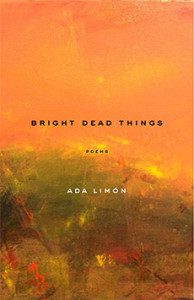
In an interview with Rumpus Poetry Book Club, Ada Limón talks about, “How death makes living all the more vivid and real.” What she said clicked my memory of Plath‟s closing lines in “Edge,” “She is used to this sort of thing. / Her blacks crackle and drag.” In Bright Dead Things, you‟ll hear the crackling of speaker’s “blacks.”
So, on a Saturday evening, I looked up on the wall trying to deduce a piece of void into a moment well articulated for my Palomar. It was then, that this book as if on some surreal mission, turned its leaf to this-
Don’t you want to lift my shirt and see
the huge beating genius machine
that thinks, no, it knows,
it’s going to come in first.
How to triumph like a girl, Pg 3
Two interviews miscarried at the last moment when I failed to instill confidence in the interviewers that being childless at thirty is not being careless or irresponsible; it bears no foretelling of my stability as an employee. And then I came home, “I put my apron on as a joke and waltzed around carrying / a zucchini like a child.” Later diced it well for a pretty salad, continuing to discover more of what the poet has categorized in four quarters.
As a child, when a minor injury would bother me and I would whine, my mother will put me to sleep. Now, when I am desolate and broken, my dope is sleep and like a poem that refuses deliberate cleverness, my little fingers would become cushions of “the pins and needles.” So, when Limón is panegyric about sleep, I nod in approval.
I’d like to take a nap.
But not a nap that’s eternal,
a nap where you wake up
having dreamt of falling, but
you’ve only fallen into
an ease so unknown to you
it looks like a new country.
The Noisiness of Sleep, Pg 40
How much of what we write are we? How much of what is found in Bright Dead Things are confessional of the poet or just a modern deviant of confessional but autobiographical of the speaker? This distinction is sorted out well in Stanley Plumly’s brilliant essay titled Autobiography and Archetypes. He says, “Archetypes is the machinery through which autobiography achieves something larger than the single life; and autobiography is the means by which archetypes are renewed.” Here, Limón’s metaphors and imagery are most often the archetypes that help her achieve something larger than one single serving of a life can offer. And this repository of archetypes is also a renewable source of literary merit made possible through the participation of readers who can identify with the speaker‟s journey in the book. This however does not fully rubbish the truth that we are only a part of what we know and in that regard there‟s a subtle but certain participation of the poet herself too.
 So, what are Bright Dead Things? This reminds me of a three year old murder mystery exposed on Indian Television recently; of a mother who killed her daughter and then to avoid being caught while on her way to dispose the body, accompanied by her industrialist lover, both together had her seated in the middle, painted her face with bright make up and gloss, as if on their way back from some who’s who party. The title of the poem hinges on a deeper socio-psychological debate around the authenticity of brightness in a common man‟s life. And like any poet who has been there, seen it, done that, it is only a natural extension of her imagination to explain a concern by using unfamiliar contexts, in this case, carrot?
So, what are Bright Dead Things? This reminds me of a three year old murder mystery exposed on Indian Television recently; of a mother who killed her daughter and then to avoid being caught while on her way to dispose the body, accompanied by her industrialist lover, both together had her seated in the middle, painted her face with bright make up and gloss, as if on their way back from some who’s who party. The title of the poem hinges on a deeper socio-psychological debate around the authenticity of brightness in a common man‟s life. And like any poet who has been there, seen it, done that, it is only a natural extension of her imagination to explain a concern by using unfamiliar contexts, in this case, carrot?
I broke the new roots
and carried them, like a prize, to my father
who scolded me, rightly, for killing his whole crop.
I loved them: my own bright dead things
I remember the carrots, Pg 14
There are very few select moments in this task of literary emblazoning, when death is tender than a marsupial. Consider this-
It’s been a long time
since I’ve wanted to die,
it makes me feel
like taking off
my skin suit
and seeing how
my light flies all
on its own, neon
and bouncy like a
wannabe star.
Field Bling, Pg 48
Poet and Critic Stephen Burt says, “Prose sense is to poetry as tonality is to music”. And I see that sense of prose cushioned in each poem included in this leguminous compilation. The works wear complexity on their sleeves with reassuring accessibility on their faces; to say it more succinctly, there’s a tough grilling of the soul and champagnes served to the measure of each one‟s taste.




